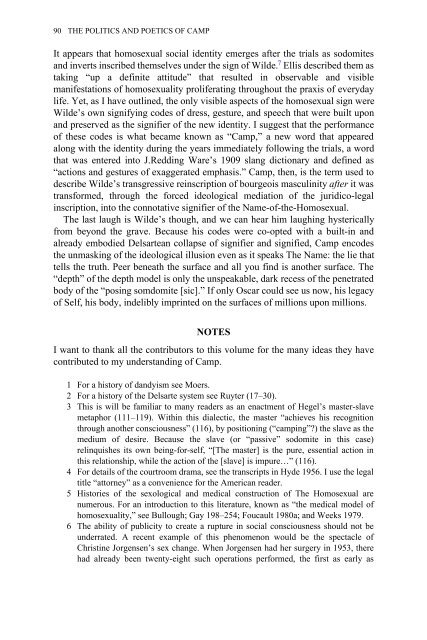Edited by Moe Meyer - Get a Free Blog
Edited by Moe Meyer - Get a Free Blog
Edited by Moe Meyer - Get a Free Blog
You also want an ePaper? Increase the reach of your titles
YUMPU automatically turns print PDFs into web optimized ePapers that Google loves.
90 THE POLITICS AND POETICS OF CAMP<br />
It appears that homosexual social identity emerges after the trials as sodomites<br />
and inverts inscribed themselves under the sign of Wilde. 7 Ellis described them as<br />
taking “up a definite attitude” that resulted in observable and visible<br />
manifestations of homosexuality proliferating throughout the praxis of everyday<br />
life. Yet, as I have outlined, the only visible aspects of the homosexual sign were<br />
Wilde’s own signifying codes of dress, gesture, and speech that were built upon<br />
and preserved as the signifier of the new identity. I suggest that the performance<br />
of these codes is what became known as “Camp,” a new word that appeared<br />
along with the identity during the years immediately following the trials, a word<br />
that was entered into J.Redding Ware’s 1909 slang dictionary and defined as<br />
“actions and gestures of exaggerated emphasis.” Camp, then, is the term used to<br />
describe Wilde’s transgressive reinscription of bourgeois masculinity after it was<br />
transformed, through the forced ideological mediation of the juridico-legal<br />
inscription, into the connotative signifier of the Name-of-the-Homosexual.<br />
The last laugh is Wilde’s though, and we can hear him laughing hysterically<br />
from beyond the grave. Because his codes were co-opted with a built-in and<br />
already embodied Delsartean collapse of signifier and signified, Camp encodes<br />
the unmasking of the ideological illusion even as it speaks The Name: the lie that<br />
tells the truth. Peer beneath the surface and all you find is another surface. The<br />
“depth” of the depth model is only the unspeakable, dark recess of the penetrated<br />
body of the “posing somdomite [sic].” If only Oscar could see us now, his legacy<br />
of Self, his body, indelibly imprinted on the surfaces of millions upon millions.<br />
NOTES<br />
I want to thank all the contributors to this volume for the many ideas they have<br />
contributed to my understanding of Camp.<br />
1 For a history of dandyism see <strong>Moe</strong>rs.<br />
2 For a history of the Delsarte system see Ruyter (17–30).<br />
3 This is will be familiar to many readers as an enactment of Hegel’s master-slave<br />
metaphor (111–119). Within this dialectic, the master “achieves his recognition<br />
through another consciousness” (116), <strong>by</strong> positioning (“camping”?) the slave as the<br />
medium of desire. Because the slave (or “passive” sodomite in this case)<br />
relinquishes its own being-for-self, “[The master] is the pure, essential action in<br />
this relationship, while the action of the [slave] is impure…” (116).<br />
4 For details of the courtroom drama, see the transcripts in Hyde 1956. I use the legal<br />
title “attorney” as a convenience for the American reader.<br />
5 Histories of the sexological and medical construction of The Homosexual are<br />
numerous. For an introduction to this literature, known as “the medical model of<br />
homosexuality,” see Bullough; Gay 198–254; Foucault 1980a; and Weeks 1979.<br />
6 The ability of publicity to create a rupture in social consciousness should not be<br />
underrated. A recent example of this phenomenon would be the spectacle of<br />
Christine Jorgensen’s sex change. When Jorgensen had her surgery in 1953, there<br />
had already been twenty-eight such operations performed, the first as early as


